A rainy morning, so it's a taxi to Santa Maria Novella, to catch the train to Bologna (pop 390,850 in 2024). After our trip to Ravenna last year, Bologna is on our travel list not only for the art and architecture, but for the food.
When we arrive Bologna Centrale, the rain clouds are gone, but the air has a chill. It's a short walk to the centro storico and our hotel under the covered walkways. Unfortunately, the office is closed so we begin the eating tour while we wait for the attendant to return.
Once we're settled, we head out to have a look around town. We pass what looks like a Christmas wreath but is a memorial on the Sinagoga Ebraica (20th century). At the Porta Nova, we make a right and find an alley lined with portici (vaulted walkways). In the distance we begin to see the towers.
The alley opens into a small piazza in front of the Chiesa del Santissimo Salvatore (17th century).
Behind the Chiesa is a parking area, cut by the shuttering for a construction site. We round the corner of the Palazzo d'Accursio (14th century) and the Torre dell'Orologio (15th century) and enter the Piazza Maggiore. This is a broad, stone-paved pedestrian square, but with curbs for a large traffic island in the center – perhaps from bygone days when there were cars.
The half-finished facade of the Basilica di San Petronio (14th century) anchors the southern edge of the Piazza. The Palazzo del Podestà (early 13th century) is opposite, on the other side of the traffic island, already lit with pink accent lights. The Palazzo dei Banchi (16th century) forms the eastern side, with the dome of Santa Maria della Vita floating above it.
The Fontana di Nettuno (Laureti & Giambologna, 16th century) sits to one side of the Palazzo del Podestà
Biblioteca Salaborsa at the center of smaller piazza space between the Podestà and the Accursio. The piazza is active and full of people wandering, unbothered by the cool weather; the people are out for their passeggiatta.
As an introduction to Bologna, the Piazza's alluring stonework is impressive and but not over scaled. From the Piazza, we wander north and continue to get a feel for the incredible town. Down the Via Rizzoli, we get a fantastic view of the Due Torri (both, 12th century).
Crossing the Via Rizzoli, we come upon the base of our first medieval tower, the Torre degli Azzoguidi (61m, 12th century), an excellent landmark but perhaps not easily adapted for use. All the vertical scale of Bologna is concentrated in these twenty or so towers.
Dinner is in the area called La Piccola Venezia; if they have canals, we did not see them. But our first taste of lasagna and ragù alla bolognese is extremely satisfying.
After a filling and warming meal, we walk back to the hotel on th Via Indipendenza, past the Arena del Sole (19th century). The Portici di Bologna are bright and sheltering, and make walking at night a real joy.
We find a gelato shop across from the Cattedrale di San Pietro (16th-17th century; facade, 18th century). Locals are gathering for a service, but we step in for a quick look.
Still needing to walk off the lasagna and gelato, we head towards the Due Torri, the Torre degli Asinelli (97m) and the Torre della Garisenda (48m). They lean towards each mother at alarming angles. The city is laced with trolley wires, but we've not seen any vehicles using them. Look through the cables, we notice the complex system of steel bracing and ties. And when we reach the base, the area is blocked off with screens and panels.
An enormous crane stands in from of the Palazzo della Mercanzia (14th century), surrounded by the images of the towers repeated on the boards.
We turn down the Via Santo Stefano, and find the Basilica di Santo Stefano ('Sette Chiese', 4th-12th centuries) is still open for visitors. we enter through the gate of the Basilica del Santo Sepolcro (5th-11th centuries).
If we didn't know from the literature and labels, we'd know from the forms and the feel of the buildings. The complex dates to Early Christian times, and like many of these designs, Santo Sepolcro is a chiesa rotonda, a round temple (roughly octagonal, twelve columns at the dome) based on the Basilica del Santo Sepolcro in Jerusalem.
The narrow ambulatory passages, the dramatic lighting, the ancient stones, and the dull shine of the Cross combine to create an otherworldly atmosphere.
The rotonda is centered, not over the burial place of Christ, but over the site of of le reliquie di San Petronio, Bologna's patron saint, found in 1141. The burial site is surmounted by a medieval edicola (shrine with grating, 11th century). The ambone (ambo, rasied pulpit), with its stairs and reliefs of the Four Evangelists are from a later date (13th century). Under the trefoil arch, an angel appears from a tomb: QUIVI RIPOSA Il CORPO DEL GLORIOSO S. PERTRONIO VESC. E PROTETT. DI BOLOGNA.
An oddly shaped black column with a series of holes is in front of the altar. The dedication says that it represents the column where Christ was whipped and guarantees two hundred years of indulgence to everyone who visits.
On the other side of the column, a doorway leads into the Cortile di Pilato (8th century).


The Cortile di Pilato, named for the place where Christ was condemned, is an intimate double-square yard enclosed by the spectacular brickwork of the Basilica on one end, and four-bay Romanesque arcades on the two longer side. In the middle is a basin on a stand, known as the Catino di Pilato (8th century).
The candlelight from the Cappella della Consolazione (16th century) flickers and draws our attention to the wonderfully faded Baroque artwork. Opposite the Basilica is the Martyrium (Chiesa della Trinità, 4th-5th centuries), a smaller vaulted space that contains a series of chapels. Seemingly out of place, the first chapel is a contemporary memorial to the Bersaglieri.
Past the Martyrium is the Chiesa della Benda (cappella and museo, 16th century), which contains an altar with a reliquary containing the Virgin Mary's mourning cloth ('bandage').
We exit through the gift shop and Il Chiostro Medievale (12th century). From here, we can look up, into the darkness, and just make out the Campanile.
We walk back out to the Piazza Santo Stefano, and then past the Due Torri. A frigid night descends, and the streets are almost empty now. The hardy Bolognesi are sitting in the Piazza having drinks and snacks.

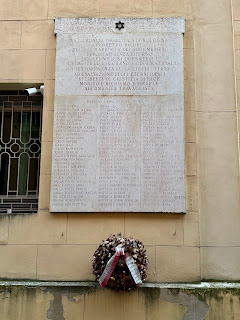




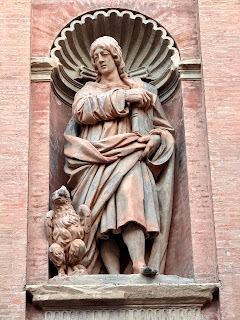




















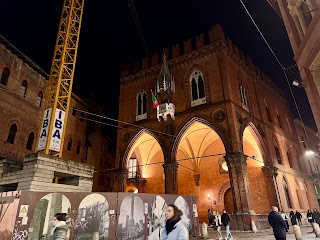





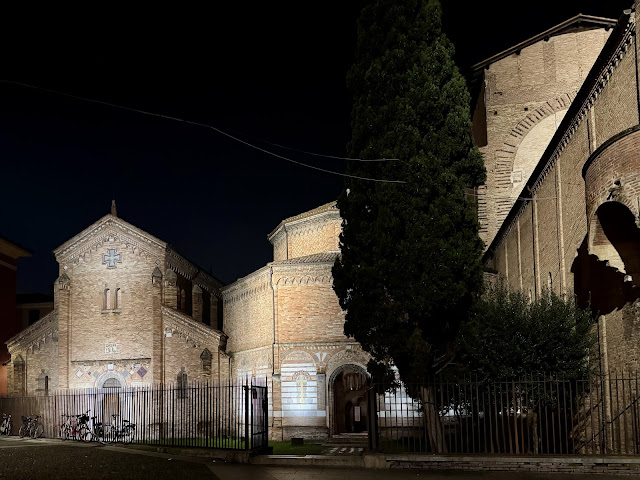







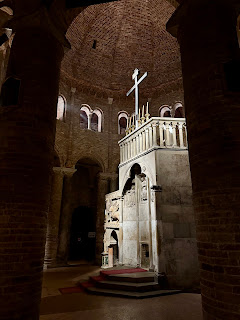



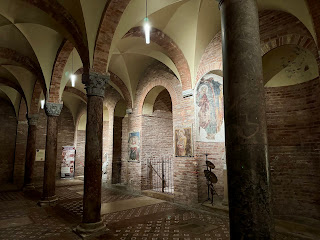









No comments:
Post a Comment